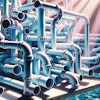
The No. 1 concern of service companies heading into this year was the ability to find and retain good workers. Dan Lenz, vice president of All Seasons Pools & Spas in Orland Park, Ill., is a pioneer in worker motivation and retention. In this article, Lenz discusses some of the incentive systems that have helped create long tenures and high retention rates at the suburban Chicago service, construction and retail store.
If you want workers to really care about what your company is trying to do, you have to look at it from their point of view. First of all, you have to give people some control over their work lives. You need to move from "This is what I'm telling you to do," to "This is what we want to accomplish — how are we going to get that done?"
That really helps people engage with their jobs. It's a lot more enjoyable to do something when you're personally involved, not just following commands like a machine. While that helps, it's even more important to show the individual, "You're not stuck in this job. This is going to be worthwhile." And by that I mean financial motivation, which is most people's bottom line.
Younger, newer workers have to see the opportunity to not just make some money but earn a living and support a family. They have to see a chance to go from an a starting hourly wage of $9 or $10 an hour to one where they can see the potential of earning $50,000, $75,000 or even six figure incomes and more.
When young workers come to believe there's an opportunity to advance financially, they strive to educate themselves and improve their skills as they develop into the caliber of people that can satisfy the customer. Satisfied customers bring in more money, both in what they pay us and in the new customers — their neighbors and friends — they bring to us. And efficient workers make more money per hour of work. So as workers bring in more money, they get paid more. It's a self-perpetuating cycle.
Get What You Give
The incentive system we use is based on the idea that your pay is related to the revenue that you bring in. And when you become motivated to bring in more money, the company revenues go up, so we can afford to pay you more. Where you once could do say, three pool equipment installations a day, and after training and experience you can now do six, you're bringing in more revenue, and you are paid accordingly.
Everybody gets a base hourly rate, and then there is a tiered system of incentives based on how much revenue the employee generates, which shows up in their weekly paycheck.
In the highest tier of that system, you get 12 percent of what you generate for the company, in addition to your base rate. It's a graduated scale where you have to generate at least $3,000 to get 3 percent back, $4,000 to get 7 percent back, and $5,000 or more to get 12 percent back. That's the top rate; if you generate $10,000, you get 12 percent of that.
So there's an incentive to be good at your job. It works like this: We don't charge by the hour; it's a flat rate to come out and look at your heater. If it's a minor part, we'll pop that in on the spot and charge you for the part, that's it. If it's a major repair, maybe we have to order something, we work that charge out with the customer.
So if it takes a guy half a day to diagnose the problem, he's only getting that flat fee in his bank for those four hours of work. But if he goes through the technical training and he becomes efficient, and can figure out the problem in 30 minutes, now he's off to the next job. So instead of doing two or three jobs a day, now we're doing six or seven or nine jobs a day. (And it impresses the customer to see someone come in, do some efficient work, fire up the heater and quickly put the pool back in action. They think, "This guy really knows what he's doing.")
The point is that the service person soon figures out that the more efficient you are, the more money you make. And money is a strong motivator. So a guy can see that, "Gee, if I can do six jobs in a day rather than three, I'll be more efficient and make more money. So how am I going to get more efficient?"
Well, there are a lot of ways to become more efficient, and when people want to find them, they usually do. Better efficiency may involve something as basic as the state of your work truck. Are you going to spend 30 minutes a day looking for parts you know are there but can't find? Or is it neat and orderly so you can just reach in and pull out the exact part you need and walk back to the pool.
These kinds of practices spread if everyone knows that efficiency leads to more pay.
Working Your Way Up
Initiating this kind of system takes commitment. First of all, young workers have to have confidence in the system — that their efforts will be rewarded. It's one thing to hear it from you, but it's another to have examples in the company who have been able to achieve financial success. It shows that we're not just giving lip service to this, that it really works. The younger worker needs to see that example, to say to himself, "Hey, I see this guy everyday, I'm out here working with him. I know where he's at, and that's where I want to be."
And you have to lay out the path to get there. It's not just a bunch of intangibles. It can't feel like a matter of luck. It has to be simple: If you go through this training, and you get this certification, and you achieve this level of ability, then within a certain timeframe, this is where you're going to be.
We trust that formula because we've found that if you're getting the training and certifications it's hard not to become effective — they don't just hand these things out. You've got to prove you understand your job in order to get them. And when you understand your job, you become more effective.
(As an aside, we've also found that people are more comfortable on the job when they are trained because they're better able to solve problems.)
Getting Started
As I mentioned, this system tends to be self-perpetuating. The hardest part was starting it up and getting it going. I worried we might go broke changing over to this kind of pay structure. I had tracked everything for years, looking at what it took on average to replace a piece of equipment, what we paid in labor, what we charged, and what we had left over at the end of the year.
I wanted to shift our pay to something more performance-based. So when we tried it, it was a matter of — crunch the numbers, hold your breath and hope it doesn't all fall apart.
But it worked. The transition took maybe three years. Once it was established, it was really easy to run. It's occurring on a weekly basis throughout the year. I've got spreadsheets I use for the calculations, in terms of hours worked and revenue generated, and it just spits out the numbers at the end, and that's what's in your paycheck. And every year, as people advance in education and experience, I go in and tweak those formulas, and we're ready for the next year.
The hardest part when we first started this was assuring the people who had been here a long time that they weren't going to lose anything — that they only stood to gain from this. That they, too, could improve and profit by it.
Because if you do anything for a handful of years, you can get caught up in just doing what you've been doing without trying to get better. You're not looking to do more, or to do better, you're just doing it again, one more day. Every morning you say, "I'm off to work, Honey, see you when I get home," and you put in your time.
But this gives that experienced person a chance to look at things and say, "I'd like to make this change so we could do this faster and better." It makes you think more, and sometimes it gives you the chance to make your jobs easier. But no matter what, it keeps you more interested in the day-to-day, and that helps retain good workers in the long term. The average tenure with us is almost 13 years.
An Industry Imperative
When I first started analyzing the data, I found we had a range of abilities on staff, and those abilities directly correlated to training and experience. Where Tech A might do a job in less than an hour, Tech C would take two and a half. Why was that?
 Shutterstock.com | ruzanna
Shutterstock.com | ruzanna
It was experience and training that led to that efficiency. And I found that our profit went up when employee efficiency went up. So rather than just keeping all that extra profit from better employee efficiency, we're giving part of it back. It's that simple.
No matter how you do it, though, we need to find a way to compensate and motivate people better. It's really why our industry has such a hard time gaining respect. Because for the majority, they're paid low wages and expected to care about what they're doing.
Efficiency Upgrade
This winter, we spent some money and a lot of time and effort replacing our computer system, switching over to a swimming pool-based product from Evosus that works with an app on their smartphones. Here's how it works: In the morning, our technicians come in and synch their data on their phone with the system, and now they've got everything they're going to do that day on their phone. When they head out, instead of going to the map book or their GPS, they tap the address on their phone and it goes straight to Google Maps and navigates them to the job.
And they use the app all day. When they get to the job, they hit "arrive." They do their work, but instead of logging on paper the parts they used, what they did, etc., they go back into the app and scan barcodes with the camera, and they enter their notes by just speaking them into the App which translates that into text: "I replaced the pump seal. I found the heater wasn't working, so I cleaned the pilot orifice. Now everything is working great." And then they hit "depart" and move on to the next job.
I always said that our technicians spend over an hour each day doing paperwork. Then after the technicians had logged everything on paper, someone back at the office always had to enter that information into the system, spending more time doing just data entry.
I wanted to save that time and expense. So we spent the money to move to this new system so we could drastically reduce that time doing paperwork, and make people more efficient.
In the course of a week, if a tech can pick up another four to six hours of billable time as a result of using this system, that's going to go straight to their bottom line. So we're investing in them, as much as we're investing in the business.
And I'll be honest, we started implementing this system in November of last year, and as with any major system change, it's been a long, rough road in transition, but there are some very good benefits.






































